-
You are here:
Home
›
-
History of South Africa
›
-
The San people
The remarkable Khoi and San people,
first known inhabitants of South Africa
Together the Khoi and the San people of South
Africa are often called the "Khoisan", a term that has been used to describe their broad similarity
in cultural and biological origins. It is derived from the names "Khoi" and "San".
"Khoi" was the original name used by the Hottentots in reference to themselves and "San" was the
name the Bushmen used when they referred to themselves.
They are the first known inhabitants of South Africa, believed to have emerged from the same
gene pools as the black people, but to have developed separately.
Both the Khoi and the San people of South Africa were resident in the country for thousands of
years beforeits written history began with the arrival of the first European seafarers.
The hunter-gatherer "San" people were ranging all over Southern Africa. Up to as recently as
3 000 years ago, all the inhabitants of southern Africa depended on hunting game and gathering wild
plant foods for their survival.
Learn more about the original inhabitants of South africa by using the
menu below;
THE KHOISAN
THE SAN PEOPLE (BUSHMEN)
THE KHOI PEOPLE (HOTTENTOTS)
VISIT THE SAN BUSHMEN
The Khoisan,...
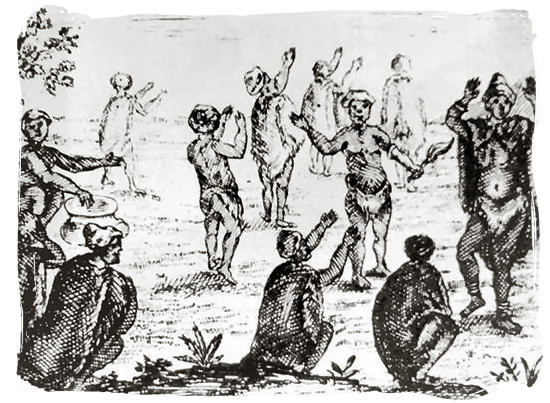
An 18th century drawing of Khoikhoi worshipping the moon
The San People or Bushmen of South Africa, also known as the Khoisan
The more pastoral "Khoi" people were to be found in the more well-watered areas along the western and southern
coastal regions. So it was that the first indigenous South Africans to come into contact with Europeans were
the “Khoi” people.
By the middle of the 20th century however, the advance of pastoral, agricultural and industrial societies have
caused most of the original inhabitants of South Africa to become assimilated into new ways of life, to be
wiped out by their enemies in conflictsover land, or to have died from the diseases brought by the new inhabitants.
Today only a small group of hunter-gatherer San people have survived.
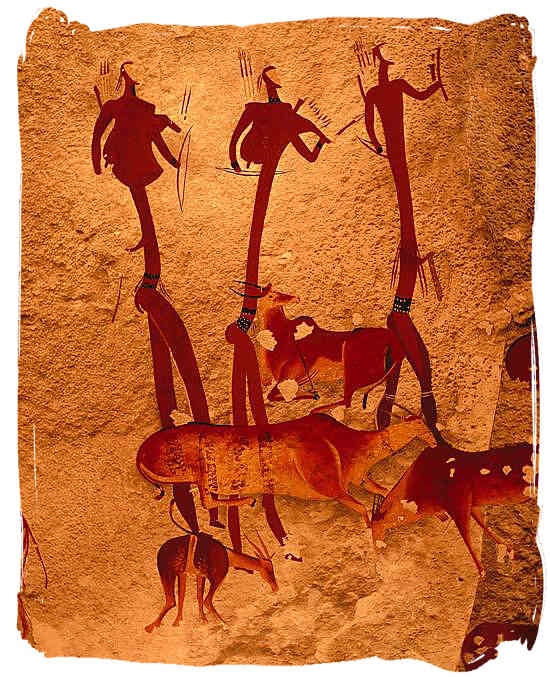
The San people have left us an invaluable legacy of marvelous paintings on rocks and cave walls as far afield as Namaqualand, the Drakensberg andsouthern Cape
copyright © South African tourism - The San People or Bushmen of South Africa, also known as the Khoisan
<<< Top of Page
The San people (Bushmen),...
The hunter-gatherers of Southern Africa have been called by many names: "Bushmen", "San" or "Sonqua", "Soaqua", "Sarwa"
or "Basarwa", and "Twa", all basically meaning, "those without domestic livestock". The San are much shorter than
members of the Black people. The average height of an adult is approximately 1,5 m and their complexion is yellowish.
They probably originated on the north coast of Africa and were then driven further and further south by stronger
nations. When the San reached the southern point of Africa, the Black tribes were primarily still living in the
tropical and equatorial parts of central Africa.
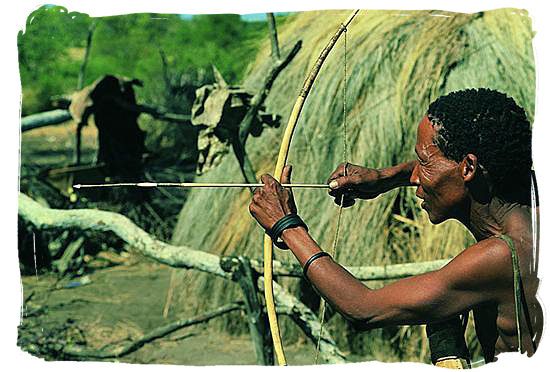
The San people hunted with wooden bow and arrow and used clubs and spears if necessary
copyright © South African tourism - The San People or Bushmen of South Africa, also known as the Khoisan
The San were known to be excellent trackers, a skill that helped them to survive for so long on the land.
They lived in caves or shelters made of branches built near waterholes, so that drinking water would be
near and animals could easily be hunted.
The San people have left us an invaluable legacy of rock art and their paintings, depicting their way of
life and their religious beliefs, can still be found all over the country. They give us a glimpse into the
lives of these tough little people, capable of such courage and compassion that they could survive on the
land for such a long time, without destroying all they touched.
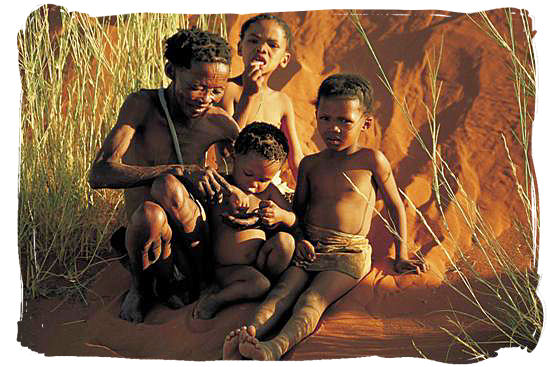
Khoisan family in the Kalahari desert
copyright © South African tourism - The San People or Bushmen of South Africa, also known as the Khoisan
There is a small group of San in the Kalahari Desert in South Africa, today, who are trying to live as
their predecessors did. It has, however, become increasingly difficult for them and most of them have
turned to either agriculture or stockbreeding to make a living.
<<< Top of Page
The Khoi people (Hottentots),...
The Khoikhoi ("men of men") or Khoi, sometimes spelt KhoeKhoe, are a historical division of the Khoisan
ethnic group of south-western Africa, closely related to the Bushmen (or San, as the Khoikhoi called them).
At the time of the arrival of white settlers in 1652 they had lived in southern Africa for about 30,000
years, and practiced extensive pastoral agriculture in the Cape region.
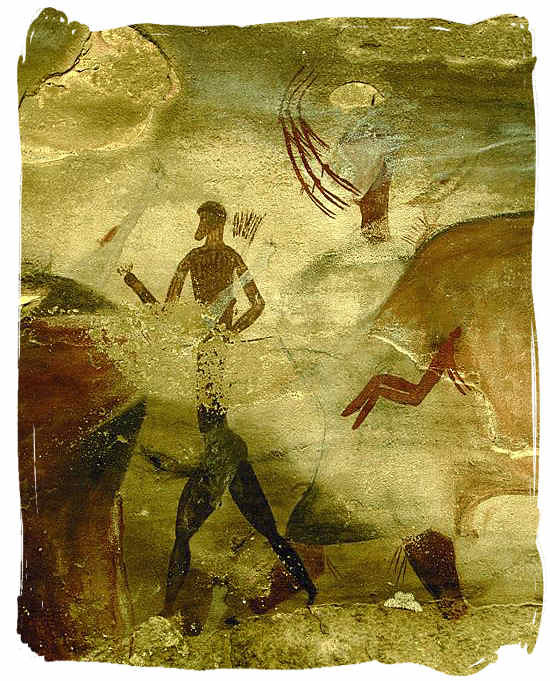
One of the thousands of rock paintings depicting the San people's way of life and their religious beliefs
copyright © South African tourism - The San People or Bushmen of South Africa, also known as the Khoisan
The Khoi people had adopted a pastoralist lifestyle (a nomadic lifestyle based on herding of cattle) some
2000 years ago and adapted their cultural lives accordingly. Like the San, the Khoi people also had a
yellowish complexion but they were bigger in size.
This can be attributed to the fact that their staple diet was protein. Their whole lives revolved around
their cattle and they were constantly on the move in search of better grazing for their cattle and sheep.
The Khoi had perfected their nomadic way of life to a fine art. They slept on reed mats in dome shaped huts
made from stripped branches which could be taken apart easily to facilitate moving. Their huts were erected
in a circle formation so that the animals could sleep in the middle.
A fence of thorny branches was constructed around the circle of huts to keep intruders from entering. In addition
to milk and meat, their diet consisted of berries, roots and bulbs. Sometimes, like the San, the Khoi used bows and
arrows to hunt.
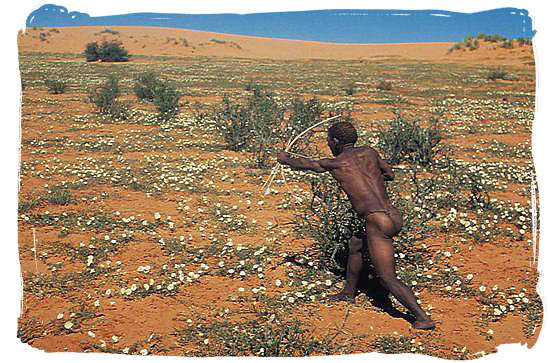
The San people lived and hunted in total harmony with nature, posing no threat to wildlife and vegetation
copyright © South African tourism - The San People or Bushmen of South Africa, also known as the Khoisan
Some scientists believe that the Khoi people originally came from the great lakes of Africa and only
migrated to Southern Africa long after the San. Other scientists, however, are of the opinion that the Khoi
shepherds evolved from hunter-gatherer communities in Southern Africa. Language studies have proven that
certain languages spoken by the San are remarkably similar to certain Khoi dialects.
Some linguists have even mentioned the possibility that the Khoi language developed out of a San language.
This is another reason for combining the words "Khoi" and "San" into "Khoisan". But the word also refers to
the deeper connection between the two peoples, which originated when they started to marry into each other's
tribes and, in this way, became one people.
With the arrival of the black and later the white people in South Africa, trouble started for the Khoisan.
The San regarded the farmers' cattle as game and started hunting them and the Khoi saw the farmers as
intruders on their grazing fields. This caused much strife between the different groups. Eventually, the
San moved to drier parts such as Namibia and Botswana.
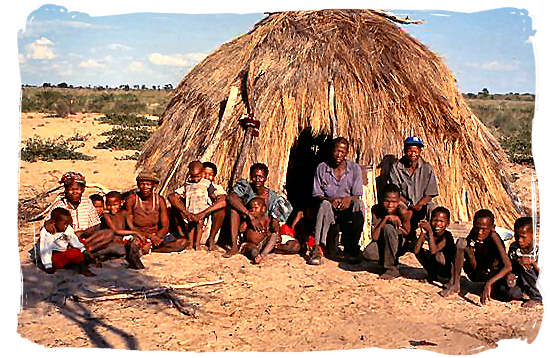
There are small number of San descendents in the Kalahari desert, living the same way as their ancestors did. This is a Bushmen community at Gope, Central Kalahari Game Reserve, Botswana
copyright © South African tourism - The San People or Bushmen of South Africa, also known as the Khoisan
Once Europeans began to colonise the Cape, the Khoi lifestyle began to change as the colonists began to
intrude on their living space and they were eventually reduced to a state of servitude. The population of
the Khoi was also severely reduced by warring and epidemics such as smallpox.
Eventually they became detribalised and started mixing with the freed slaves. Because of all these changes, the
Khoi people ceased to exist as a nation, although they numbered nearly 100 000 when the Dutch arrived in 1652.
Top of Page
-
Home
›
-
History of South Africa
›
-
The San people

